In this article:
The skin undergoes a lot of wear and tear daily as it is the most exposed organ of the body. The good thing is it is fully capable of repairing itself.
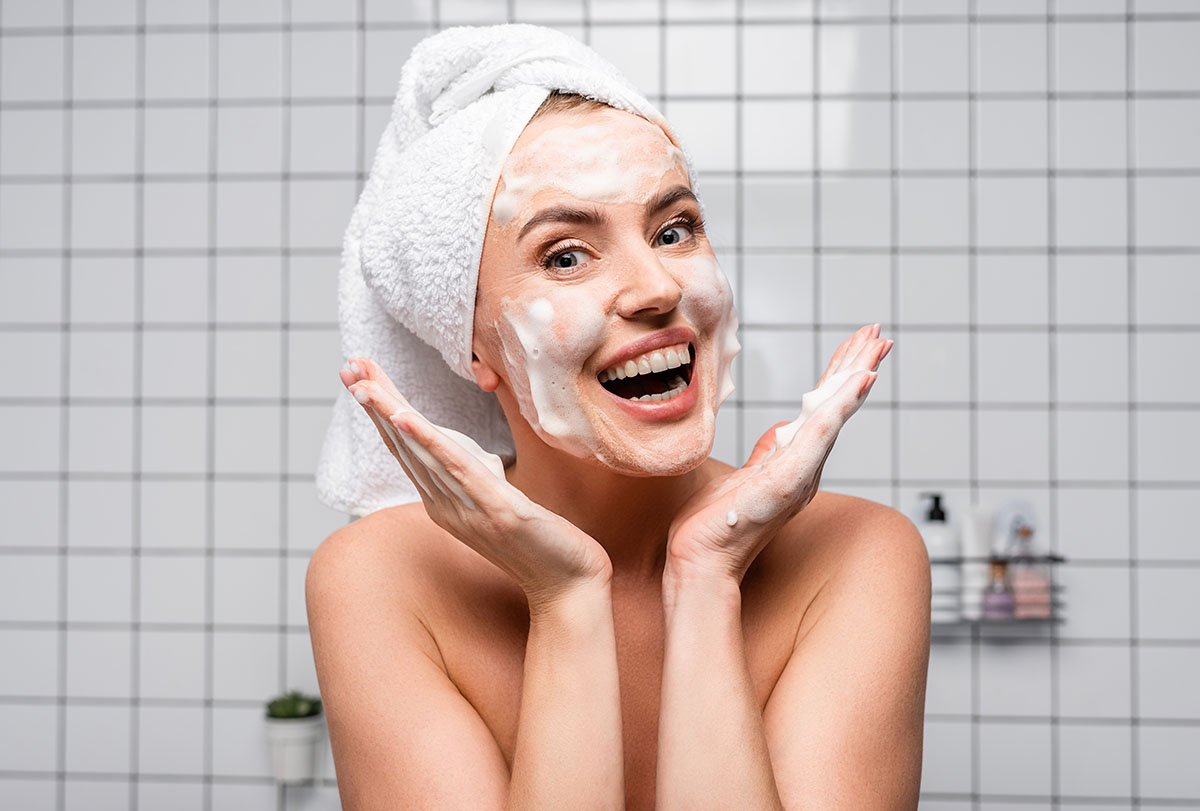
The skin has multiple layers, but it’s the outermost layer called the epidermis that faces the direct onslaught of irritants and injuries that cause cellular damage. The dead and damaged skin cells accumulate on the surface but are gradually sloughed off into the environment to be replaced by new cells that rise from underneath.
Skin regeneration is a slow process, which is why no one really notices it while it’s happening. It takes almost a month for the body to shed the entire epidermis and replace it with a freshly formed layer.
However, certain factors and conditions can accelerate this process to make your skin peel and flake out. This causes both physical discomfort and cosmetic distress, especially if it happens on your face. Facial skin is thinner than the skin of the body, makes it more prone to irritation and damage.
This article brings you some ways to address mild or early-stage skin peeling as well as what you must do when the condition becomes chronic.
Causes and Symptoms
Some of the common culprits behind skin peeling are environmentally caused or natural skin dryness, inflammatory skin conditions such as eczema or psoriasis, an adverse reaction to skin care products, certain medications, hypothyroidism, and allergies.
The affected areas become rough, dry, itchy, red, and tender to touch. Without proper care and treatment, the skin may even bleed or become infected.
Treatment for Chronic Skin Peeling
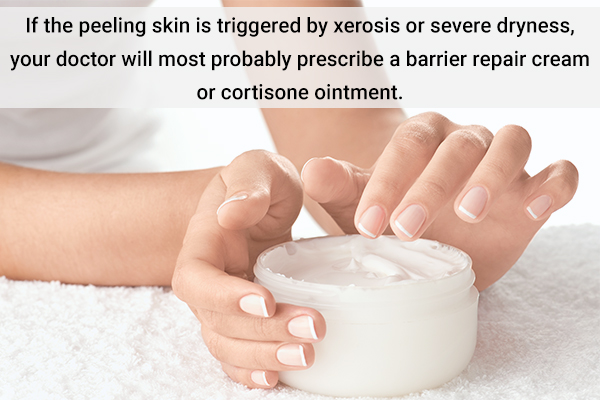
Your doctor will properly evaluate your condition and recommend the appropriate medical treatment based on the underlying cause, severity of symptoms, and complications, if any.
Treatment options usually include the following:
- If the peeling skin is triggered by xerosis or severe dryness, the doctor will most probably prescribe a barrier repair cream or cortisone ointment. (1) To control the itch triggered by the condition, 1% hydrocortisone cream is usually recommended. Cortisone is a steroid that curbs the inflammatory response that makes your peeling skin itchy, swollen, red, and tender. However, excessive use of steroids can wear out your skin and induce complications, so it is very important to use them following the doctor’s guidelines. Plus, steroids tend to make your skin drier, so it’s best to use a moisturizer after applying them. Doing so will also seal in the ointment.
- If your peeling skin shows signs of infection, the doctor will most probably prescribe an antibiotic ointment, such as mupirocin or nadifloxacin (Nadoxin), to curb the microbial growth.
- Stronger steroids and antihistamines may be prescribed if the skin peeling is triggered by an allergic reaction. (2)
Skin Care for Peeling Skin: Choose the Right Products
Mild forms of skin peeling can usually be addressed through proper skin care using gentle, chemical-free products that will promote healing without causing added irritation or dryness.
These products are specifically designed to meet the needs of your sensitive skin, such as:
- Promoting collagen synthesis to facilitate speedy skin regeneration and improve elasticity
- Providing proper hydration to banish dryness
- Curbing inflammation
- Loosening the skin flakes for easy shedding
Make sure your skin care products are hypoallergenic, which ensures that they are free of skin irritants such as parabens, artificial fragrance, alcohol-based extracts, formaldehydes, and artificial dyes, which can exacerbate your condition.
Plus, skin care products should be noncomedogenic, which means that the product will not clog your skin pores. Some other products that you should invest in include:
1. Moisturizers or hydrating gels
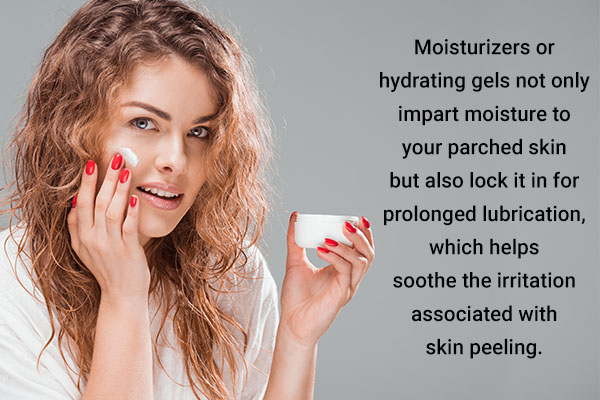
When your skin peels, its barrier function becomes compromised, making it delicate and vulnerable to infections.
Moisturizers or hydrating gels not only impart moisture to your parched skin but also lock it in for prolonged lubrication. This helps restore and strengthen the skin barrier and also soothe the irritation associated with skin peeling.
Here are a few ingredients that can make a moisturizer especially helpful for treating peeling skin:
- Dimethicone
- Sodium hyaluronate
- Beeswax
- Niacinamide
- Glycerine
- Meadowfoam seed oil
- Chia seed oil
- Algae extract
- Licorice root
- Allantoin
- Squalene
- Feverfew extract
- Plant-based ceramide
- Eucalyptus extract (3)
- Buckwheat
- Honey
2. Nonfoaming cleansers
Regular skin cleansers contain harsh chemicals that give them fragrance and lather but strip the natural lipids from your skin to leave it utterly dry. Applying such cleansers on your already sensitive peeling face can exacerbate the skin damage, dryness, and irritation.
So, it is important to look for chemical-free cleansers that gently remove dirt and sebum from your face without further irritating the outer skin layer. Plus, you should look for cleansers that contain hydrating ingredients that moisturize and also cleanse your skin.
Here are some ingredients that you need to look for:
- Hyaluronic acid
- Fruit enzymes (pineapple or papaya)
- Cucumber extract
- Rose water extract (4)
- Ceramides
- Niacinamide
3. Antioxidant serums
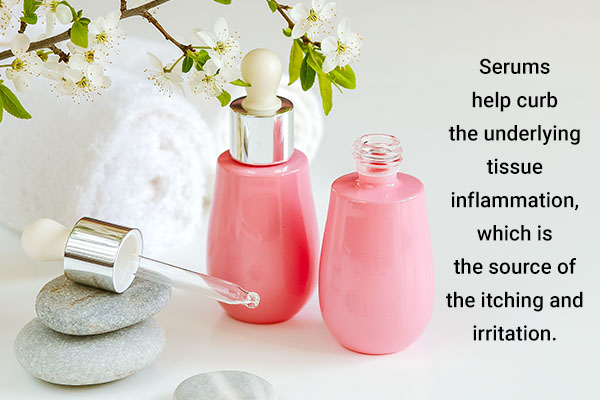
Antioxidant serums help protect your skin from free radicals and repair the cellular damage already caused by them. These serums also help curb the underlying tissue inflammation, which is the source of the itching and irritation. (5)
Some of the ingredients that exhibit strong antioxidant activity that you should look for in such serums include:
- Vitamin C
- Japanese purple rice extract
- Pomegranate extract
- Grapeseed extract
- Calendula flower extract
- Bilberry extract
- Ferulin
4. Hydrating face mask
Hydrating face masks contain ingredients such as chamomile wax, vitamin B3, calendula, aloe vera, borage seed oil, rose oil, marula oil, baobab oil, and passion fruit oil extract that moisturize, nourish, and heal the skin.
Plus, these masks help seal moisture in your skin to keep it hydrated for longer.
5. Face wipes
You can purchase soft face wipes that contain moisturizing ingredients that are ideal for cleaning your face from time to time.
Keeping your face clean is imperative to avoid skin infections, but washing it frequently will only add to the dryness. This is why using hydrating face wipes is a better and safer option.
Look for the ones that contain skin-healing vitamins along with ingredients such as grapefruit extract, lemongrass extract, tea tree oil, honey, and Greek yogurt.
Home Remedies for Mildly Peeling Skin
Disclaimer: Home remedies can be tried only if it is confirmed by your dermatologist that the cause of your peeling skin is skin dryness and not dermatitis.
Here are some home remedies that can help soothe and repair a mild case of peeling skin.
1. Plant oils
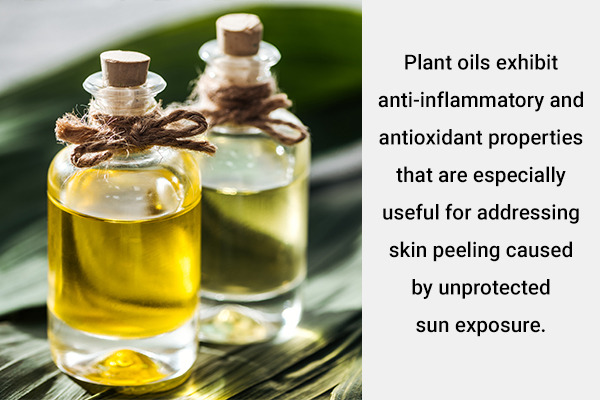
Plant oils enrich the skin with both moisture and healing nutrients. They also exhibit anti-inflammatory and antioxidant properties that are especially useful for addressing skin peeling caused by unprotected sun exposure. (6)
Some commonly used oils include coconut oil, (7) olive oil, (8) argan oil, jojoba oil, rosehip oil and other oils containing vitamin E, and castor oil.
How to use:
- Wash your face.
- Massage a few drops of your preferred oil on your face using circular motions.
- Reapply when your skin starts to feel dry again.
2. Natural fats
Shea butter, (9) mango butter, (10) milk or milk cream, cocoa butter, (11) and avocado butter are natural fats that can work as hydrating and enriching skin moisturizers due to the linoleic and oleic fatty acids in them.
How to use:
- Dip a clean washcloth in cold, full cream milk, and then cover your face with it for about 10 minutes. Take off the cloth and wash your face with water.
- You can also directly apply shea butter, avocado butter, or milk cream on the peeling skin in place of your regular moisturizer.
3. Honey
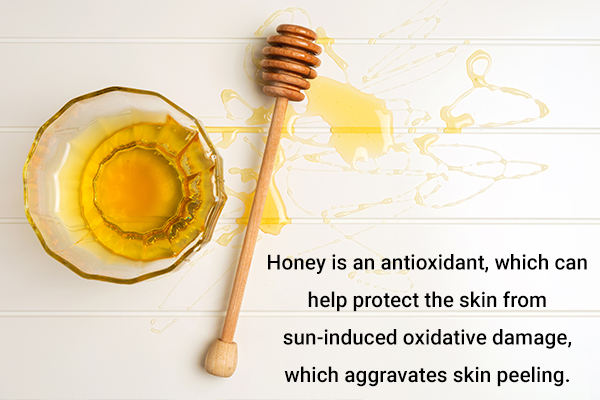
Honey is enriched with natural sugars called fructose and sucrose, which give honey its hydrating properties. Honey is also a humectant, which means it traps moisture from the air and seals it in your skin.
Not just that, honey is an antiseptic, which can help fight or prevent skin infection. (12) It is also an antioxidant, which can help protect the skin from sun-induced oxidative damage, which aggravates skin peeling. (13)
How to use:
- Gently massage raw organic honey all over your face.
- Leave it on for 10 minutes before washing it off.
4. Aloe vera gel
Aloe vera gel contains a compound called aloin, which is known to stimulate skin healing. It also contains mucopolysaccharides that deeply hydrate the skin to make it soft and supple. (14)
How to use:
- Simply scoop out the gel from a freshly cut aloe leaf and gently massage it all over your face in gentle, upward, circular motions. Leave it on your skin for 15 minutes and then wash it off.
- You can also mix a hydrating oil such as vitamin E oil (break open vitamin E capsules) or coconut oil to the gel for added skin benefits.
5. Oatmeal
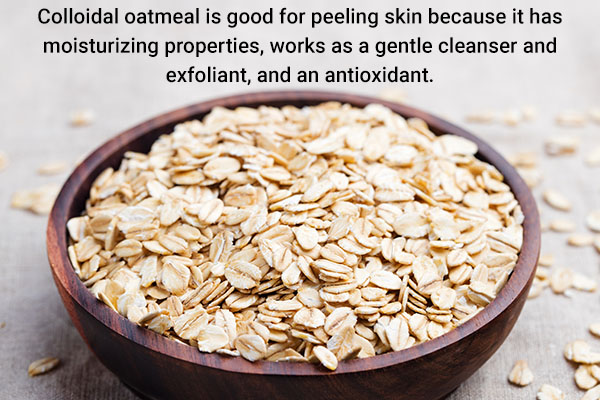
Colloidal oatmeal is good for peeling skin in more ways than one. For starters, its moisturizing properties help reduce the dryness and tenderness.
It also works as a gentle cleanser and exfoliant, aiding in the removal of flaky skin without adding to the irritation. Plus, colloidal oatmeal is an antioxidant that protects sensitive skin from further free radical damage, curbs inflammation, and promotes healing.
All these properties together help alleviate dry and itchy skin and reduce sunburn-associated inflammation. (15)
How to use:
- Combine 2 cups of warm water and 1 cup of rolled oats in a bowl. Let the oats soak for about 20 minutes so that they become soft. Then, apply the oatmeal to your face and let it sit for about 20 minutes before washing it off with warm water. This remedy loosens the dead skin flakes on the surface of your face so they are easier to remove. Gently massage a soft cloth over your face to shed the dry skin.
- You can also mix 2 tablespoons of ground oatmeal with ½–1 teaspoon of honey and a little water or milk to make a paste. Massage this mixture on your face using gentle circular motions of your fingertips. Leave it on for 10 minutes and then rinse it off with warm water.
Self-Care Measures
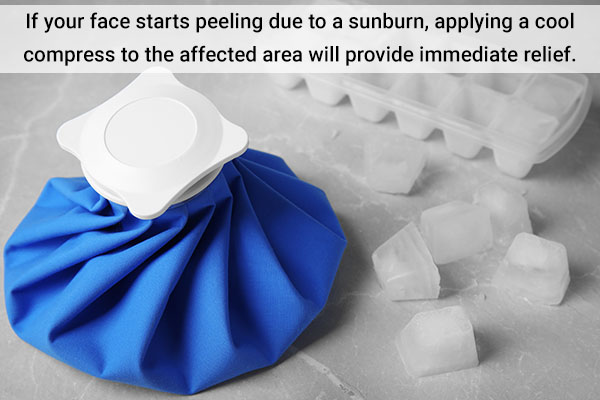
Follow these self-care measures along with the recommended treatment and remedies to help your skin recover faster, minimize symptomatic discomfort, and prevent any further peeling:
- If your face starts peeling due to a sunburn, applying a cool compress to the affected area will provide immediate relief. You can make your own compress by wrapping a few ice cubes in a clean washcloth and sealing it with a knot. Place the compress over your sunburnt skin for 5 minutes, remove it for 5 minutes, and then reapply it for another 5 minutes. Do this multiple times a day to soothe the discomfort. You can also wash your peeling skin with cool water to soothe the uncomfortable post-peel sensation. Cold therapy helps numb the targeted area by curbing blood flow and desensitizing the underlying nerve endings, making you feel less pain, but only temporarily. Direct or prolonged application of ice on sunburnt skin can damage the underlying tissue and even induce frostbite.
- Don’t dry your skin by rubbing a towel over it as this can further irritate your sensitive skin. Instead, gently pat the towel over the damp areas to soak up the moisture.
- Moisturize your skin 2–3 times a day, especially after washing your face. (16)
- The skin of the lips is very thin. So, protect your lips by applying a lip balm with SPF.
- Your body requires water to maintain skin elasticity and to promote cellular turnover for skin repair. (17) So, it is very important to keep yourself well hydrated by drinking 8–10 glasses of water daily. Although water is the best source of hydration, you can also diversify your fluid intake by consuming cucumber juice, coconut water, citrus fruit juices, and green tea.
- Limit your intake of alcohol and caffeine, which are known diuretics that increase your urine output, ultimately causing your body to lose more water than it consumes. This will further dry out your skin and make the peeling worse.
- Consume a healthy, well-balanced diet to keep your skin properly nourished and to promote fast healing. Poor nutrition adds to skin dryness, which can exacerbate the peeling. (18) Include nuts, freshwater fishes, flaxseeds, chia seeds, soybean oil, and canola oil in your diet. These are rich sources of omega-3 fatty acids, which have been shown to be very good in managing dry skin. (19) Vitamin D deficiency can also cause skin dryness; therefore, consume foods rich in vitamin D, such as milk and eggs.
- Whenever you are about to step out in the sun, make sure to apply a good amount of sunscreen (gels or creams) to the exposed areas of the skin.
- Look for sunscreens that contain zinc and/or titanium, offer broad-spectrum protection, and have an SPF of at least 30. You can also purchase moisturizers that contain sunscreen. (20)(21)
- Avoid touching your face as much as possible.
- Don’t use makeup to conceal the peeling patches as this will only make it more noticeable and will further irritate or damage your skin.
- In arid climates, use a humidifier to keep the air inside your home properly moist. Living in a dry environment can suck the moisture from your skin, making it increasingly dry and worsening the peeling.
When to See a Doctor

Skin peeling can sometimes stem from a serious or even life-threatening condition that requires prompt medical attention. Here are a few warning signs that should alert you to such a possibility and prompt you to consult a doctor:
- Sudden-onset skin peeling without a discernible cause
- Painful, swollen, or severely red and tender areas of skin peeling
- Hives, rash, or blisters, including blisters in the mouth
- Nausea, diarrhea, or vomiting
- Any large burn, especially if the person is a child, elderly, or otherwise sick
- Fever or chills
Final Word
Skin peeling can be triggered by a variety of reasons, ranging from something as common as dry weather or sun exposure to serious medical conditions that require prompt treatment. So, it is important to first get a proper diagnosis to understand the seriousness of your condition before you treat it.
Most mild cases can generally be addressed at home with proper self-care and home remedies, along with nonprescription ointments and moisturizers. Given that this concerns your face, it’s best that you let your dermatologist guide you to the best course of treatment rather than self-treat and make the condition worse.
- Was this article helpful?
- YES, THANKS!NOT REALLY


